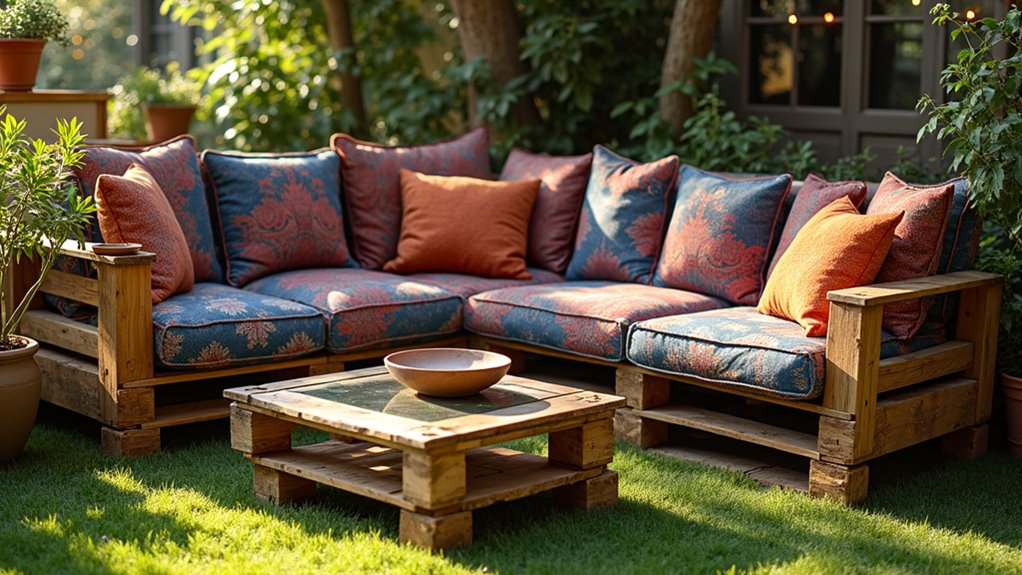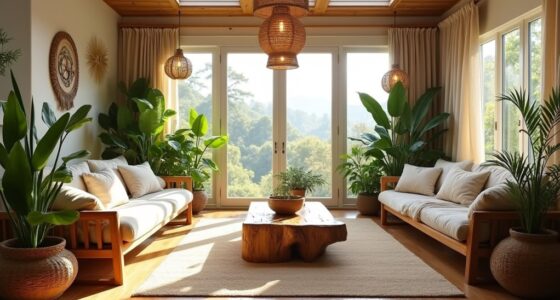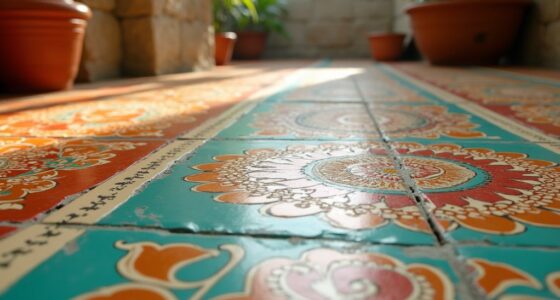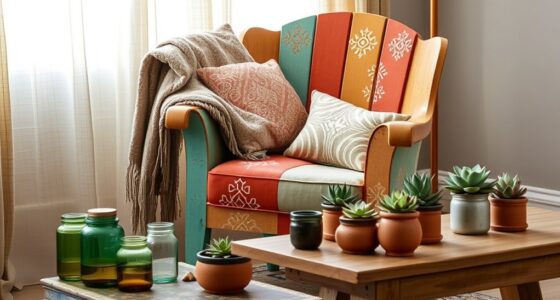To craft bohemian pallet furniture like sofas, beds, or tables, start by selecting sturdy, chemical-free pallets stamped with ISPM MB or EUR. Carefully prepare and sand them, then plan your design on paper. Build a strong frame with support beams, add cushions and textiles for comfort, and finish with paint, stain, or sealant for protection. Incorporate decorative touches and keep maintenance in mind to create a personalized piece—continue to explore how each step brings your boho vision to life.
Key Takeaways
- Select sturdy, chemical-free pallets stamped with ISPM MB or EUR for safety and durability.
- Plan your design with accurate measurements, including support elements like 2x4s for stability.
- Carefully deconstruct pallets, then cut and assemble pieces to create the desired sofa, bed, or table structure.
- Sand surfaces thoroughly and finish with paint, stain, or protective coatings to enhance appearance and longevity.
- Add textiles, cushions, lighting, and decorative accessories to personalize and elevate your bohemian pallet furniture.
Selecting and Preparing the Perfect Pallets

When selecting pallets for your DIY furniture, it’s vital to choose ones that are safe and durable. Look for pallets stamped with ISPM MB or EUR, which indicate they’re free from chemicals and pests, making them suitable for furniture projects. Inspect each pallet thoroughly for mold, stains, bird droppings, or damage—discard any that show signs of contamination. Avoid pallets previously used for food or with chemical treatment labels, as they can pose health risks. Prefer sturdy, clean pallet wood with minimal splintering, and steer clear of those with broken boards or loose nails to guarantee your furniture’s durability. If needed, bleach or sand heavily contaminated pallets for added safety. This careful selection process guarantees a safe, long-lasting foundation for your DIY furniture.
Planning Your Design and Layout
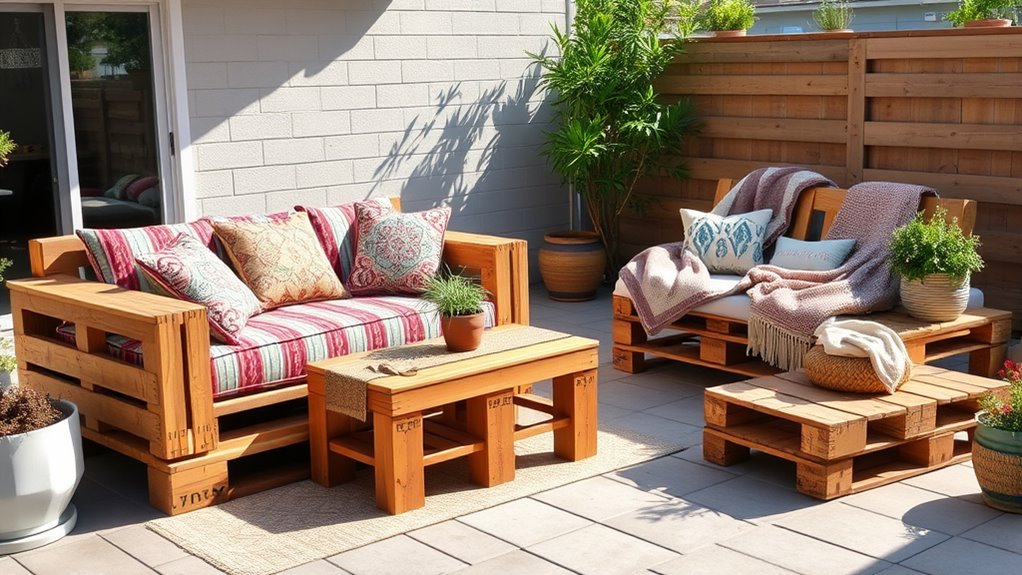
Start by sketching your furniture to visualize the size and layout, considering your space and pallet dimensions. Measure and select sturdy, pest-free pallets that fit your design, deciding if you’ll keep them whole or cut for customization. Plan support elements like 2x4s to guarantee stability, and make a list of tools and materials you’ll need to bring your design to life. To enhance the farmhouse aesthetic, incorporate rustic lighting fixtures and vintage decor elements into your plans. Additionally, choosing authentic farmhouse textiles such as rough linen or cotton fabrics can add warmth and charm to your furniture pieces. Recognizing the significance of personal development can inspire your creative process, infusing your project with positive energy and intention.
Essential Design Considerations
Planning your pallet furniture design begins with accurate measurements of your available space to determine the ideal size and shape, ensuring your piece fits comfortably. Focus on pallet design and layout planning to visualize the final look. Consider comfort elements like cushions, armrests, and backrests during sketching. Decide on the number and orientation of pallets—stacked for height or side-by-side for length—to match your style. Material selection is essential; choose sturdy, safe pallets that match your aesthetic. Also, plan for additional accessories like paint or decorative items to enhance functionality and appearance. Use the table below to explore arrangement options and material choices to help craft a well-balanced, personalized piece.
| Aspect | Details |
|---|---|
| Arrangement Options | Stacking, side-by-side, mixed configurations |
| Material Selection | Euro pallets, disposable, treated wood |
| Comfort Consideration | Cushions, armrests, back support |
Optimal Layout Strategies
Designing your pallet furniture layout involves carefully considering how each piece will fit within your space and how the arrangement affects both functionality and appearance. Start with space planning by measuring your indoor or outdoor area to determine maximum dimensions, ensuring proper fit and ease of movement. Sketch a detailed layout to visualize the final design, including the number of pallets, their arrangement, and additional features like cushions or tables. Focus on stability by considering weight distribution, especially for seating or beds, to prevent wobbling. Incorporate modular design principles, enabling you to rearrange or expand your furniture seasonally. Plan for accessible electrical outlets or lighting, and allocate space for functional elements such as storage or side tables, creating a versatile and balanced layout. Being aware of local store hours can help you plan your shopping for materials or tools needed for your project. Additionally, considering best modern toilet options can enhance the overall bathroom experience if your space includes a bathroom area. When designing for comfort, include ergonomic considerations to ensure your furniture is both stylish and functional. Also, understanding home essentials can guide you in selecting durable and suitable materials for your pallet furniture, and paying attention to safety guidelines can help prevent accidents during construction and use.
Building the Frame and Base Structure
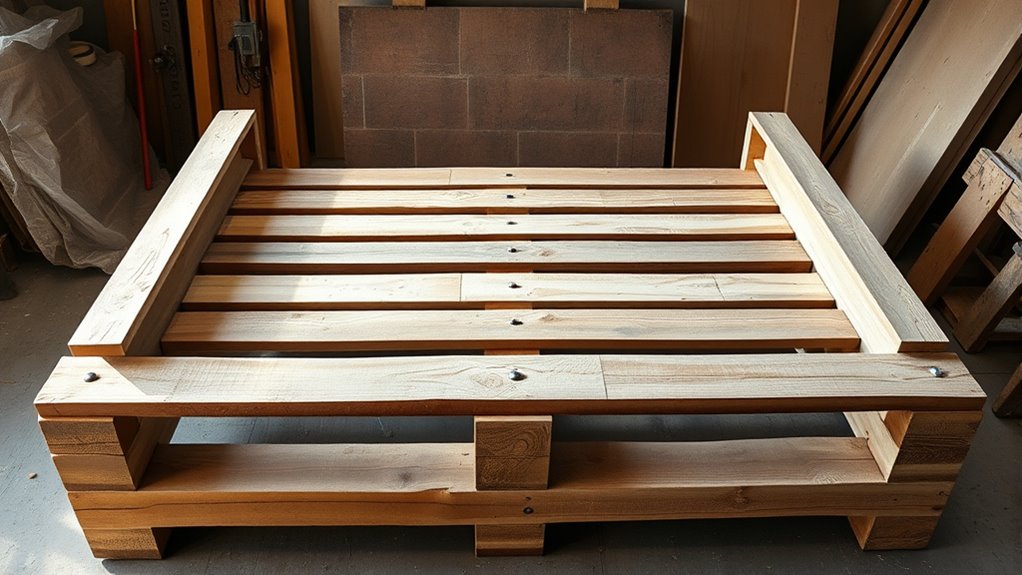
Building the frame and base structure begins with selecting high-quality, chemical-free pallets that are free of mold or pests, preferably marked with ISPM stamps like MB or EUR for assurance. Start by deconstructing your wooden pallets carefully using a saw to remove nails and separate the planks, creating manageable pieces for your DIY project. Next, measure and cut 2x4s to the desired length, ensuring they fit snugly beneath the pallet surface to support the structure. Attach these to the underside of the pallet using screws and a right angle drill, forming a sturdy pallet frame. Finally, reinforce the frame by adding additional 2×4 supports at key stress points, making sure your base remains stable and capable of bearing weight over time.
Adding Comfort With Cushions and Textiles
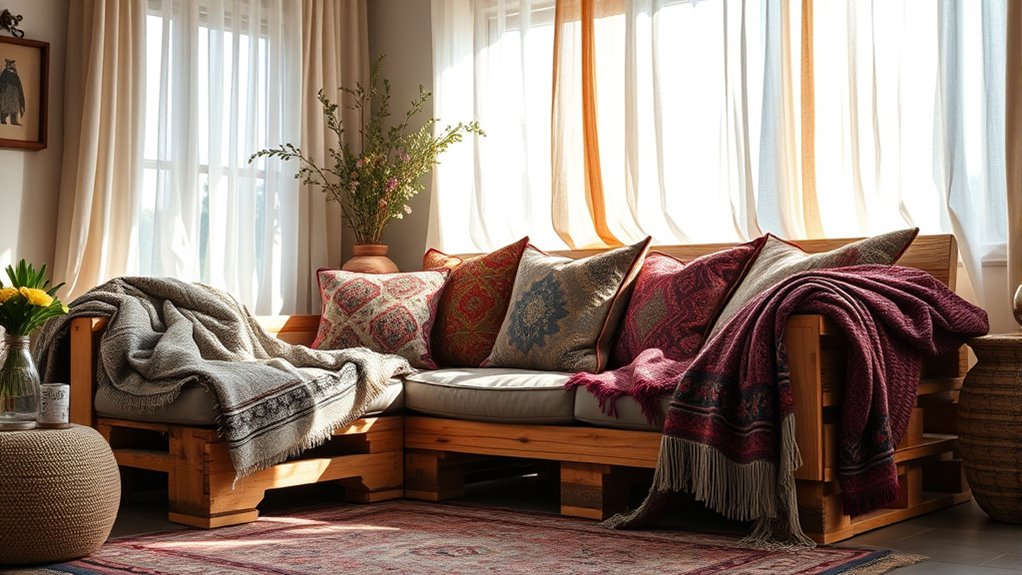
To make your pallet furniture more inviting, choose cozy fabrics like fleece throws and textured cushions that add visual interest. Layering with outdoor rugs, throws, and cushions not only boosts comfort but also creates a stylish, boho-chic look. Opt for cushions with removable covers for easy cleaning and quick updates to your decor. Incorporating textile selection insights can help you design innovative furniture concepts that blend functionality with aesthetic appeal. Selecting the right fabric type ensures durability and comfort for everyday use. Exploring cushion filling options can further enhance the comfort and longevity of your cushions.
Choosing Cozy Fabrics
How can you make your pallet furniture truly inviting? The secret is choosing the right cozy fabrics. Start with plush textiles like fleece throws and embroidered cushions to soften your space. Next, add variety with cushion textures such as faux fur, Moroccan fringed pillows, and embroidered covers, creating visual interest and warmth. Adding high-quality fabrics can significantly enhance comfort and durability in your furniture. Additionally, selecting fabrics with colorfast dyes helps prevent fading over time, maintaining your furniture’s vibrant look. Incorporating these cozy fabrics thoughtfully can elevate your pallet furniture into a welcoming, bohemian retreat. To further enhance comfort, consider integrating body awareness techniques to select fabrics that feel inviting to the touch and support your relaxation. Understanding fiber types can also help in choosing the most comfortable and durable textiles for your project.
Layering for Comfort
Layering cushions and textiles instantly enhances the comfort of your pallet furniture, making it more inviting for relaxing or socializing. Using layered cushions, like foam with embroidered or faux fur covers, adds plush comfort and visual interest. Incorporate cozy throws and blankets, such as diamond-patterned throws, for seasonal adaptability and extra warmth during cooler nights. Covering cushions with washable fleece throws simplifies maintenance while keeping your outdoor space stylish and comfortable. Mixing different textures and sizes of cushions and textiles helps define your area, making it feel personalized and welcoming. Additionally, selecting organic and natural fabrics can further elevate the sustainability and comfort of your setup. Being mindful of DIY furniture practices ensures your pieces are both functional and eco-friendly. Considering the safety of electric heated mattress pads can also be beneficial if you want to add warmth to your space safely during colder months. For added convenience and comfort, choosing appropriate cushion fillings can significantly improve your furniture’s overall feel and durability. Moreover, incorporating layered textiles allows you to easily update your furniture’s look to match different seasons or decor styles.
Easy Maintenance Tips
Adding cushions and textiles that are easy to maintain guarantees your pallet furniture stays comfortable and inviting year-round. To achieve this, choose washable cushions with outdoor fabric and weather-resistant upholstery, making cleanup simple. Use removable covers that you can toss in the wash to protect against dirt, spills, and weather damage. Imagine:
- Plush cushions with dense foam padding for lasting comfort.
- Colorful throws and blankets layered over textile layers to add coziness.
- Removable covers that slide off easily for quick cleaning.
A focus on durable, child-safe materials can help prevent the buildup of dirt and grime, extending your furniture’s lifespan while maintaining its inviting appeal. Regularly check for worn or damaged textiles, replacing them as needed to keep your furniture looking fresh. Additionally, selecting easy-to-clean materials can help prevent the buildup of dirt and grime, extending your furniture’s lifespan while maintaining its inviting appeal. These simple tips help extend your furniture’s lifespan while maintaining its inviting appeal.
Painting, Staining, or Finishing Your Piece
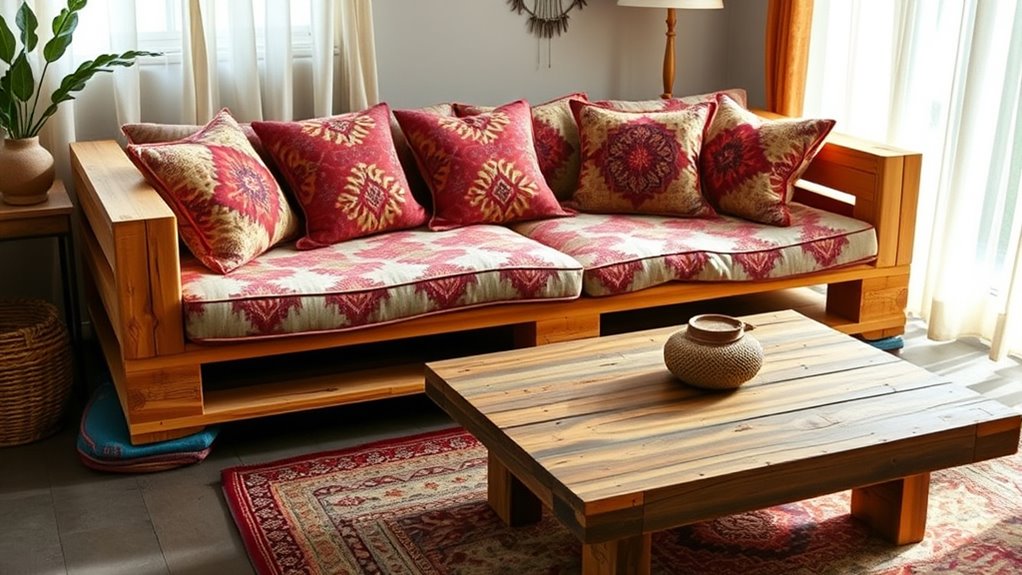
To achieve a smooth and vibrant finish on your pallet furniture, start by sanding the surface thoroughly to remove rough spots and guarantee even absorption of stain or paint. Use water-based stains or paints for a natural or bold look, while minimizing fumes and drying time. Applying a primer before painting or staining can enhance adhesion and improve color vibrancy, especially with dark or bright shades. Once you’ve finished staining or painting, seal your piece with a clear, protective sealant like polyurethane or wax to boost durability and water resistance.
| Step | Action |
|---|---|
| 1 | Sand surface smoothly |
| 2 | Apply primer for bold or dark colors |
| 3 | Finish with a protective sealant |
Incorporating Functional and Decorative Elements
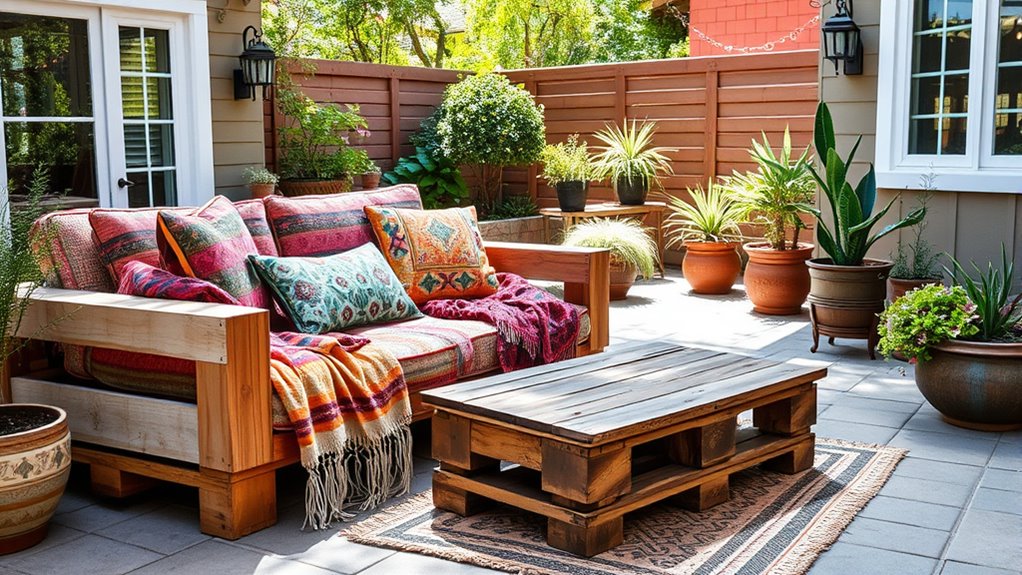
Enhancing your pallet furniture with functional and decorative elements transforms your pieces into personalized, practical accents for any space. You can do this by adding:
Transform your pallet furniture with decorative textiles, lighting, and natural accents for a personalized and functional touch.
- Decorative textiles like throws, cushions, and garlands to boost comfort and visual appeal.
- Functional features such as storage compartments, side tables, or built-in planters to increase usability and integrate natural elements.
- Lighting like LED string lights or lanterns to create a warm, inviting atmosphere around your furniture.
Combine natural materials such as recycled wood, woven fabrics, and greenery to achieve a boho-chic, earthy vibe. Personalize your pallet furniture with embellishments like painted patterns, tassels, or Mother of Pearl accents for a truly unique touch.
Styling and Accessorizing for a Boho Look
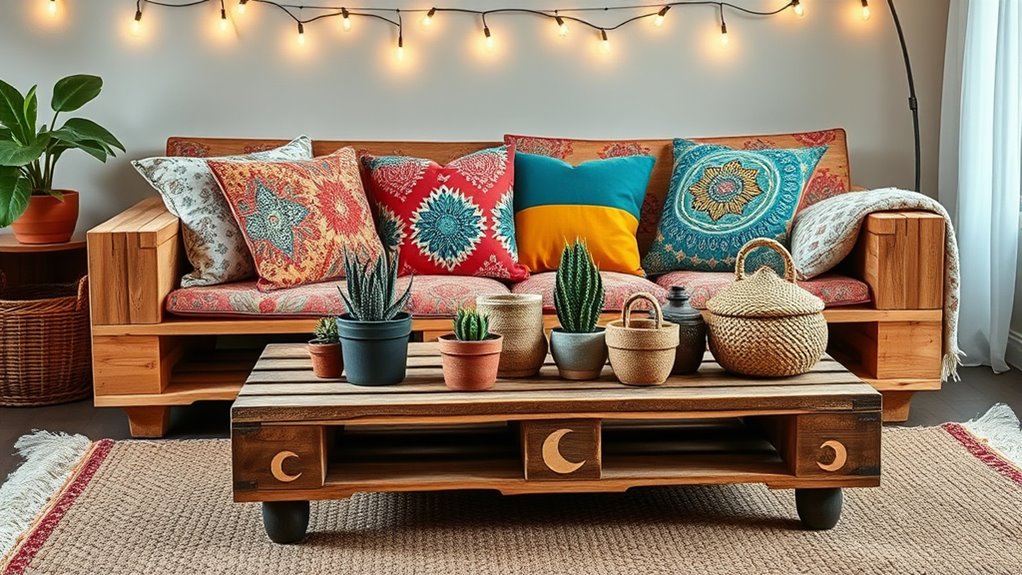
Achieving a boho look with your pallet furniture involves thoughtfully layering textiles, accessories, and natural elements to create a relaxed and eclectic vibe. Start by adding layered cushions in different patterns and textures, like embroidered cushions and fringed pillows, to boost visual interest and comfort. Drape faux fur throws over your seating for extra coziness. Incorporate decorative accessories such as vintage lanterns, string lights, and recycled planters to enhance the bohemian vibe. Hang garlands made from Mother of Pearl or natural materials for a layered, eclectic feel. Define your space with waterproof outdoor rugs crafted from recycled materials, featuring vibrant, earthy tones. These elements work together to create a welcoming, personalized oasis that embodies effortless boho charm.
Maintaining and Caring for Your Pallet Furniture
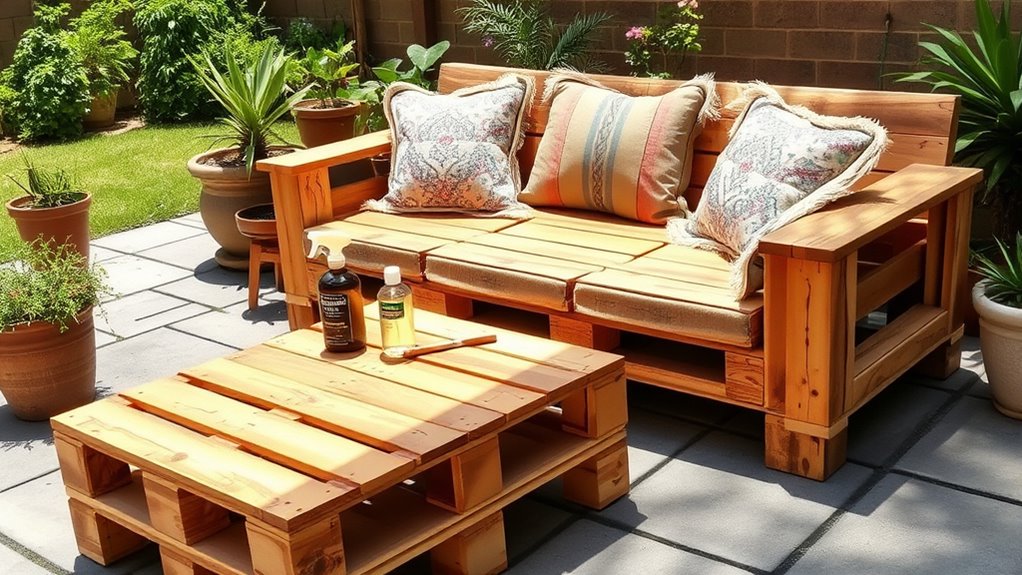
Keeping your pallet furniture looking great requires regular maintenance and care. First, inspect your pieces for signs of wear, splinters, or loose nails, and fix these issues promptly to ensure safety and durability. Second, clean the surfaces with a damp cloth and mild soap, avoiding harsh chemicals that can damage the wood or strip the protective finish. Third, apply a sealant or outdoor-grade stain periodically to boost weather resistance, especially if your furniture is outside. Also, sand rough edges or splinters after exposure to weather to keep surfaces smooth and prevent injuries. To extend your furniture’s lifespan, store it in covered areas during harsh weather. Proper maintenance, including the right protective finish, keeps your DIY pallet furniture sturdy and beautiful for years to come.
Tips for Customizing and Personalizing Your DIY Project
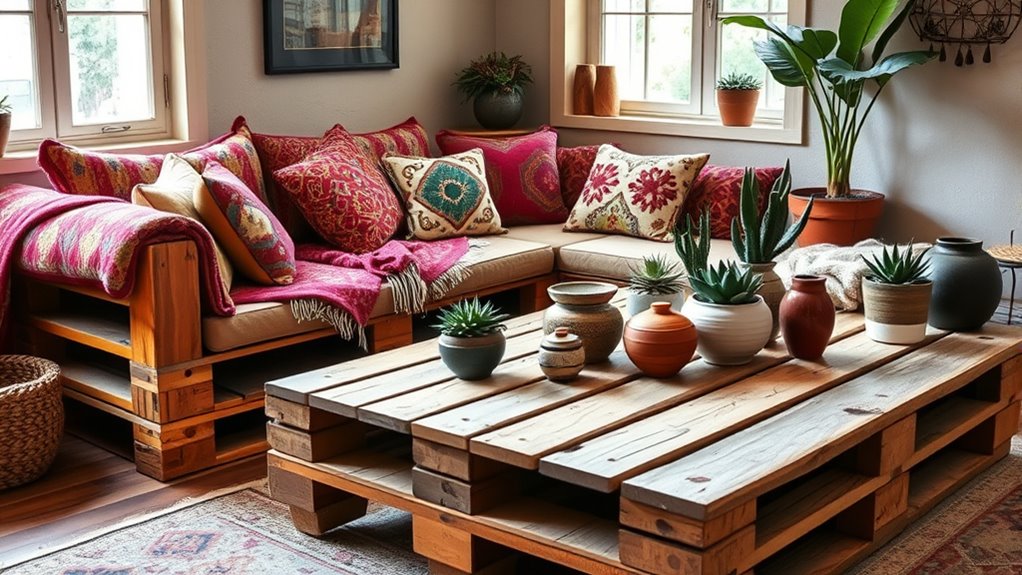
To make your DIY pallet furniture truly stand out, personalization and customization are key. Use reclaimed pallet wood or weather-resistant paint to protect and add unique character. You can customize sizes and shapes by cutting pallets to fit your space perfectly, ensuring a tailored look. Incorporate decorative textiles like cushions or throws to reflect your personal style and add comfort. Adding lighting such as LED string lights can create a cozy ambiance and highlight your design. Patterns or painted accents on reclaimed wood can boost visual interest and showcase your individual aesthetic.
| Customization Tip | Description |
|---|---|
| Reclaimed Pallet Wood | Use for a rustic, eco-friendly look. |
| Weather-Resistant Paint | Protects outdoors and adds color. |
| Decorative Textiles | Cushions and throws for style and comfort. |
| Size & Shape | Cut pallets to fit your space. |
| Lighting & Accents | Use lights or painted patterns for flair. |
Frequently Asked Questions
How Many Pallets Do You Need for a Pallet Couch?
You wonder how many pallets you’ll need for your pallet couch. Typically, three to four pallets work for a standard sofa, including the base, backrest, and armrests. For a small two-seater, two pallets might suffice, with cushions for comfort. If you’re aiming for a larger sectional, plan for five or more pallets. Always measure your pallets and decide on your desired size to determine the exact number.
What Are the Disadvantages of Pallet Furniture?
They say “look before you leap,” and that’s wise with pallet furniture. Its disadvantages include potential health risks from chemicals or pesticides, rough surfaces and splinters, and variable wood quality that can lead to breakage. Outdoor pallets may deteriorate quickly if not sealed, and pests like termites can infest untreated wood. These issues mean you need to weigh safety and durability before diving into your DIY project.
How to Turn Pallets Into a Couch?
To turn pallets into a couch, start by selecting sturdy, pest-free pallets with ISPM stamps. Sand all surfaces thoroughly, then clean them with a brush or hose. Arrange the pallets in a rectangular shape for the base and backrest, securing them with screws or brackets. Add cushions, throws, and pillows for comfort and style. Finish by sealing or painting to protect and enhance your DIY pallet couch’s look.
How Do You Make Pallets Look Nice?
To make pallets look nice, you start by thoroughly sanding them with a random orbital sander to remove splinters and rough spots. Then, apply a high-quality stain, paint, or sealant to enhance their appearance and protect against weathering. Add decorative touches like cushions or throws to hide imperfections and bring visual interest. Regularly clean and maintain them, and incorporate complementary furniture to create a cohesive, stylish space that highlights your rustic charm.
Conclusion
Now that you’ve learned how to craft your own bohemian pallet furniture, isn’t it rewarding to see your unique style come to life? With a little creativity and effort, you can transform simple pallets into stunning, functional pieces that reflect your personality. So, why not start your DIY journey today and turn everyday materials into beautiful, cozy furniture that’s all your own? Your perfect boho oasis awaits—are you ready to create it?
